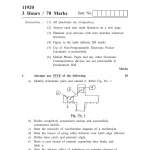MSBTE (Maharashtra State Board of Technical Education) is responsible for conducting various diploma courses in engineering and technology. To assist students in preparing for exams, it is essential to understand the previous year’s question papers. These questions can give a fair idea of what to expect in terms of patterns, difficulty, and topic emphasis. This guide provides detailed questions and answers to help students prepare thoroughly for their exams.
Subject: Computer Engineering
Question: What is a computer?
Answer: A computer is an electronic device that processes data and performs tasks according to a set of instructions, known as programs.
Question: What are the primary components of a computer?
Answer: The primary components include the Central Processing Unit (CPU), memory (RAM), storage devices, input devices (keyboard, mouse), and output devices (monitor, printer).
Question: Define software.
Answer: Software is a collection of programs and data that tells the computer how to perform specific tasks.
Question: What is an operating system?
Answer: An operating system is software that manages hardware resources and provides services for computer programs.
Question: Describe the role of the CPU in a computer.
Answer: The CPU is the brain of the computer. It executes instructions from programs and processes data.
Question: What is RAM?
Answer: RAM (Random Access Memory) is the memory used by the computer to store data that is currently being used or processed.
Question: Explain the difference between RAM and ROM.
Answer: RAM is volatile memory that loses data when the computer is powered off, while ROM (Read-Only Memory) is non-volatile and stores permanent data.
Question: What is a hard drive?
Answer: A hard drive is a storage device used to store data permanently, even when the computer is turned off.
Question: Define input and output devices.
Answer: Input devices are used to send data to the computer (e.g., keyboard, mouse), while output devices display or produce results from the computer’s processing (e.g., monitor, printer).
Question: What is an algorithm?
Answer: An algorithm is a step-by-step procedure or set of rules for solving a problem or completing a task.
Question: Explain the term ‘database’.
Answer: A database is a structured collection of data that is stored and accessed electronically.
Question: What is the difference between hardware and software?
Answer: Hardware refers to the physical components of a computer, while software consists of the programs that run on the hardware.
Question: What is the purpose of a compiler?
Answer: A compiler translates high-level programming language code into machine language that the computer can execute.
Question: What is a programming language?
Answer: A programming language is a set of instructions used to communicate with a computer and perform tasks.
Question: Describe the function of the motherboard.
Answer: The motherboard is the main circuit board of the computer, connecting all the components like the CPU, memory, and storage devices.
Question: What is meant by the term ‘network’?
Answer: A network is a group of computers and devices that are connected to share resources and data.
Question: What is the role of the operating system in file management?
Answer: The operating system is responsible for organizing and managing files, including storage, retrieval, and modification.
Question: Define a virus in computer terms.
Answer: A virus is a malicious program designed to infect and damage files, software, or hardware.
Question: What is cloud computing?
Answer: Cloud computing refers to delivering computing services like storage, processing, and software over the internet.
Question: What is the difference between a website and a web application?
Answer: A website is a collection of linked web pages for information, while a web application performs specific tasks or services for the user.
Latest Posts
- Step-by-step guide to download and apply for jee mains admit card 202
- Comprehensive 2025 government holidays and recruitment details for job seekers
- JEE Mains Admit Card 2025: Your Step-by-Step Guide to Downloading the Hall Ticket
- Everything You Need to Know About 2025 Government Holidays Recruitment
- Comprehensive Guide to rrb d group recruitment 2025 – Eligibility, Vacancies, and Application
- Detailed guide to nps trust recruitment 2025 vacancies, eligibility and apply process
- Comprehensive guide to hpcl recruitment 2025 notification, vacancies, and application process
- ignou bed admission 2025 complete recruitment guide with eligibility and process
- Comprehensive Guide to Indian Army Agniveer Recruitment 2025 Notification and Jobs
- Everything You Must Know About CBSE Board Exams 2025 Changes & New Rules



